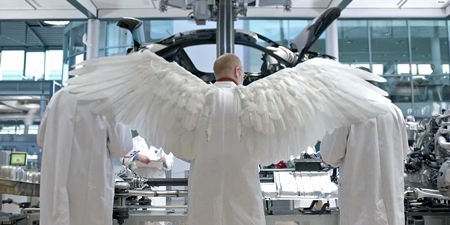Car buyers in the U.S. are more likely to be persuaded by traditional marketing, rather than blogs, forums and social media, which are often seen as less reliable and ‘infiltrated’ by brands.
This is in stark contrast to China, the world’s largest auto market, where almost one third (31 percent) of buyers see consumer-driven content – such as automotive blogs or reviews on social media – as their most trusted source of information, compared to just seven percent (7 percent) in the U.S.
The Automotive Path to Purchase Study (TAPPS) by global research consultancy TNS, shows that brand-controlled sources, particularly TV and press ads, are most influential in the U.S. buying process. Almost six in ten (59 percent) of U.S. car buyers cite these as their most trusted source, compared to 43 percent in China.
 VW gives you wings as well as Red Bull?
VW gives you wings as well as Red Bull?
Although social media still has a role to play in narrowing down choices, car manufacturers looking to build their name in the U.S. should focus their efforts first and foremost on traditional media. The study also shows TV advertising has the biggest effect in persuading buyers to consult other sources of information, whether that is a brand’s website, a car dealership or friends and family.
Andy Turton, Global Development Director at TNS, said, “Digital-savvy car buyers in the US are increasingly suspicious of brand involvement when it comes to supposedly ‘independent’ sources like blogs and forums. In China, where the car market is comparatively young and people are keen to explore new digital channels, it’s a different story.”
“That’s not to say that social and digital channels should be neglected entirely in the US. In fact the biggest success stories are where auto brands successfully integrate digital engagement with more of the old-style ‘Mad Men’ advertising strategies.”
The latest Super Bowl TV advertisement from Volkswagen has been praised for successfully translating to social media. The ad, which shows German engineers suddenly sprouting wings as cars they designed pass the 100,000-mile mark, was accompanied by a staggered social media campaign across Facebook and Twitter.
While most U.S. buyers show an affinity to American brands – including Chevrolet and Ford – the study shows it is actually foreign brands that are most effective in linking up all their different channels to convert interest to purchase. Honda is most effective at pulling buyers through from initial consideration to final purchase, with Toyota following close behind.
In both the Chinese and U.S. markets the role of the dealer is also critical in persuading buyers to part with their cash. Almost four in ten (38 percent) of U.S. buyers and one quarter (26 percent) of Chinese buyers cite dealers as their most reliable information source.
Turton concluded, “The idea of the dealer being the car buyer’s ‘best friend’ is abundantly clear in both markets. As the US auto market shows continued signs of recovery – with over 15.6 million vehicles sold last year – it is only brands that can keep customers engaged throughout the whole buying process that will see these rewards.”




